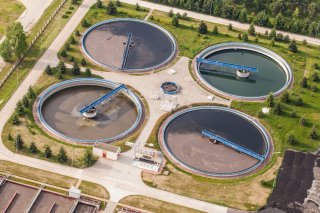Wastewater Contaminants Research

- PFAS
- Microbial Contaminants
- Antimicrobial Resistance
- Biosolids
- Related Research
- Models and Tools
- Publications and Resources
EPA research is developing and applying new techniques and analytical methods for priority and emerging biological, chemical, and other contaminants in wastewater systems. This research will improve methods for evaluating chemical mixtures, quantify risks from priority and emerging contaminants, and develop improved surrogates for monitoring the effective removal of contaminants.
Per- and Polyfluoroalkyl Substances (PFAS)
PFAS are a growing concern in water treatment but data are lacking on the sources and control of PFAS entering wastewater treatment plant operations. EPA is providing research results on the types, concentrations, fate, transport, and transformation of PFAS in wastewater treatment operations. Researchers are evaluating treatment and pre-treatment technologies for removing PFAS at high concentration sources (e.g. textile manufacturing facilities) to minimize consequences to downstream treatment or disposal operations. The goal is to identify major contributors of PFAS in biosolids and wastewater, with an emphasis on upstream prevention and pre-treatment strategies for minimizing PFAS contamination in water resources. Results from this research inform strategies, technologies, and processes for pre-treating sources prior to discharge to publicly owned treatment works and/or commercial treatment facilities.
Microbial Contaminants
EPA is identifying and evaluating alternative indicators for fecal pollution and viruses from wastewater treatment operations. In addition, researchers are determining the microbial loads and the effect of water treatment approaches on the removal of microbial contaminants in wastewater. Extraction standard operating procedures will also be developed for contaminants of emerging concern. Specific activities include the following:
- Development of advanced tools, technologies, and analytical methods for identifying and quantifying exposure to and health effects from known and emerging microbial contaminants for the development of human health criteria.
- Increasing understanding microbial contaminant removal capabilities of resource recovery water technologies and wastewater treatment plants for water reuse efforts.
Antimicrobial Resistance
The emergence of antibiotic resistant pathogens is a major public health concern. While resistance is known to occur due to antibiotic overuse, either in humans or animals, there is an increasing need to understand the role of environmental transmission of antimicrobial resistance. Since antibiotic-resistant bacteria and antibiotic-resistant genes have both been detected in wastewater, EPA is conducting research to better understand this group of contaminants. Specific areas of focus include the following:
- Assessment of relative contributions of hospital and residential wastewater flows to antimicrobial resistance in sewer networks.
- Characterization of antimicrobial resistant bacteria and genes in biosolids.
- Development of a PCR panel for the broad-range analysis of antibiotic resistant gene-related fecal pollution in wastewater.
- Assessment of antimicrobial resistant bacteria and gene loadings on wastewater treatment plants using molecular and cultivation-based assays and improving bacterial concentration methods.
Biosolids
Biosolids are a product of the wastewater treatment process and have the potential for beneficial use. Land applied biosolids must meet strict quality standards as described in existing regulations (Biosolids Rule in 40CFR Part 503 Standards for the Use or Disposal of Sewage Sludge). There are several data gaps related to the occurrence, fate and transport, and management of pollutants found in biosolids, with potential human health effects from land applied biosolids. EPA and EPA-supported research is focused on several aspects of the identification, quantification, and treatment of chemical and microbial pollutants in biosolids, including
- characterization of antibiotic resistant bacteria/genes in biosolids;
- occurrence, fate, and transport of PFAS, and other contaminants of concern, in biosolids;
- thermal treatment of biosolids;
- pretreatment strategies; and
- contaminants and land application.
Related Research
- Water Reuse and Wastewater Research
- Onsite Non-Potable Water Reuse Research
- Alternative Wastewater Treatment Research
- Research on Per- and Polyfluoroalkyl Substances (PFAS)
Models, Methods, and Tools
- EPA Science Models and Research Tools (SMaRT) Search
- Environmental Technologies Design Option Tool (ETDOT)
